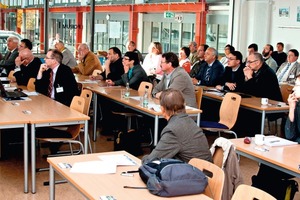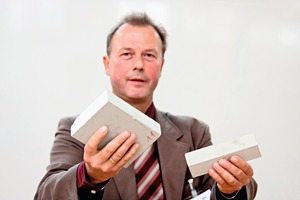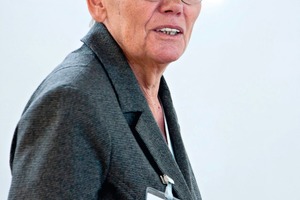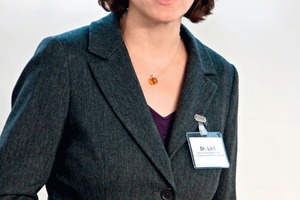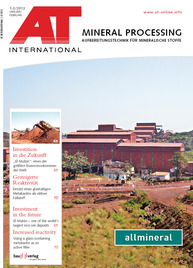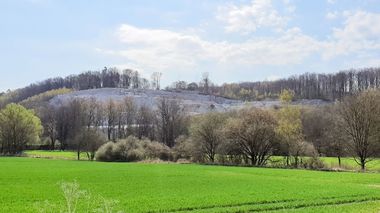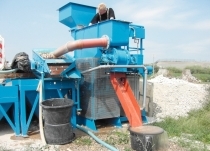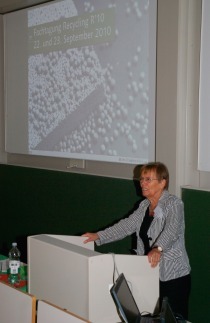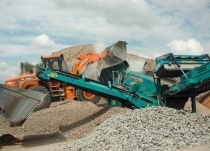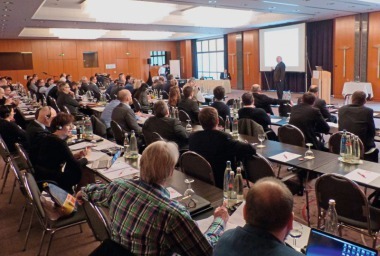7th Thuringian Building Materials Conference focussing on recycling
New insights and research findings concerning the use of recycled concrete, the current and future volume of gypsum contained in building rubble and waste, and ash-loam components as an example of the use of substitute mineral building materials were presented at the
7th Thuringian Building Materials Conference on 3 November 2011, which was organized by the Unternehmerverband Mineralische Baustoffe (UVMB Trade Association for Mineral Building Materials) and the REDUMAD Product Developments Network and held at the August-Kramer-Institute of Nordhausen University of Applied Sciences in Nordhausen/Germany (Fig. 1).
The findings of the three-year research project “ALEKOM” – a joint project of the BTU and Dr. Krakow Rohstoffconsult Göttingen – were presented by Prof. Dr. rer. nat. Dr.-Ing. habil. Klaus-Jürgen Hünger (Fig. 2) from Brandenburg University of Technology, Cottbus. In the meantime, in the scope of this project it had been possible to produce “brick size” specimens in addition to small-size building elements. Objective of this project is the production of small-size building/shaped elements on the basis of an ash-bonded fine-grained system. Crucial here from the ecological point of view was, as the speaker explained, that a firing process is not necessary. The strength of the shaped elements developed during drying at air temperatures of 20 °C based on the formation of ettringite in the ash-clay mixture, said Prof. Hünger. 28 days after production, strengths over 10 N/mm2 could be reached. The environmental compatibility of elements for use in technical structures was proven. An optimization of the mixture of different ashes with regard to chemical-mineralogical and granulometric aspects was currently in progress. Here microstructural properties, the sulphate bonding in the ashes and microstructural stability on intensive water contact are to be further improved. In addition, for application variations with intensive water contact outside of technical structures, more work was to be done on the environmental compatibility of the ash-bonded fine-grained system.
In the Federal Republic of Germany, around 34.9 mill. t building rubble are processed annually in mobile plants with another 29.1 mill. tpa being processed in stationary plants. The essential technical and economic challenges of recycling are related to the continuous availability of recyclates in the required volume and quality, proof of economic benefits compared to natural gravel concrete and in the reduction of impurities. Against this background, Prof. Dr.-Ing. habil. Anette Müller (Fig. 3) from IFF Institut für Fertigteiltechnik und Fertigbau Weimar e.V. (Institute for Prefabricated Systems and Prefabricated Construction Weimar) and Dr.-Ing. Elske Linss (Fig. 4) from the F.A. Finger-Institut für Baustoffkunde (Finger-Institute of Building Materials Science) at the Bauhaus University of Weimar reported on new research findings. Prof. Müller sees opportunities for recycled concrete particularly in areas with a high population density in conjunction with a low availability of natural raw materials deposits, as examples from Southwest Germany show. For the Free State of Thueringia, the potential would have to be rated as low. On account of the high requirements, in Germany only around 1.5 % recycled aggregates were used. Problematic here was particularly the gypsum content in the building rubble. For the separation of gypsum, two processes had been investigated. Wet separation by means of jigging was, as speaker explained, relatively complex and not very effective. On the other hand, gypsum components could be reduced substantially with dry, sensor-controlled compressed air sorting. For sulphate-containing demolition waste, two-stage processing could be recommended, said Dr.-Ing. Elske Linss. Field tests on a processing line had shown that after the first crushing stage the sulphate content in the 0/56‑mm fraction is still over 0.45 mass %. With the application of a second crushing stage, this content could be lowered to 0.15 mass % and therefore below the 0.2 mass % limit for impurities as specified in DIN EN 12620.
These findings are the result of the UFOPLAN-Project 370933317 conducted by the Federal Institute for Materials Research and Testing, Berlin, and the Bauhaus University of Weimar as commissioned by Germany’s Federal Environment Agency for the optimization of the deconstruction/demolition of buildings for the recovery and processing of building materials with the removal of harmful substances (especially sulphate) of the RC material and the ecobalance comparison of the use of primary and secondary raw materials including recycling. The objective is to elaborate recommendations for a procedure for recovering high-grade RC aggregates. In the scope of the project, current and future volumes of gypsum in the building waste in Germany are to be recorded and the demolition and processing techniques investigated in respect of the removal of gypsum. A gypsum volume of around 5.5 mill. t/a relative to 57 mill. t/a building rubble has been determined, which corresponds to a quota of almost 10 mass %. The trend was going upward and presented a challenge for building material recycling, said Dr Linss, as more and more gypsum products were being used. For the year 2030, the gypsum volume in building waste is forecast to double.

